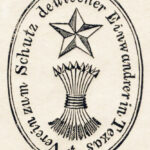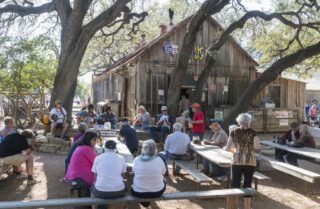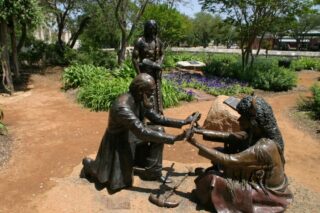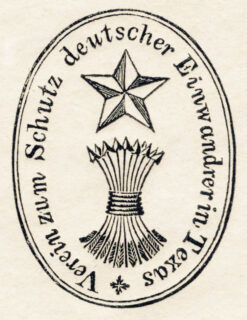Texas Germans’ Migration and Knowledge
A Miniseries on Nineteenth-Century Germans’ Migration to Texas and Knowledge Transfers
With contributions by Jana Weiss, Abigail Escobedo and Simon Herbert, Jacob Johnson and Taylor Mullins, Rodolfo Alvarez and Aubrey Hernandez, Aiden Maliskas and Mark McShaneIntroduction
Wurstfest, New Braunfels’s annual sausage festival, has been wildly successful since its inception in 1961. Attracting roughly 2,000 festival goers in its debut year,1 the celebration has grown immensely, with over 200,000 visitors attending the festival in 2022, establishing itself as one of the top festivals in the country. Each year, the festival introduces new attractions and features on a trial-and-error basis;2 however, its foundations as a celebration of local sausage makers, accessorized with Alpine-Bavarian style decor, has remained unchanged, linking it back to the city’s German roots. New Braunfels was founded in 1845 by the Mainzer Adelsverein, an organization of German noblemen who hoped to establish a strong German colony in the Texas Hill Country by means of organized mass migration. With its high turnout year after year, what knowledge might the creators of Wurstfest have had in relation to German-Texan foodways, ethnicity, and the local economy when they developed the festival in 1961?
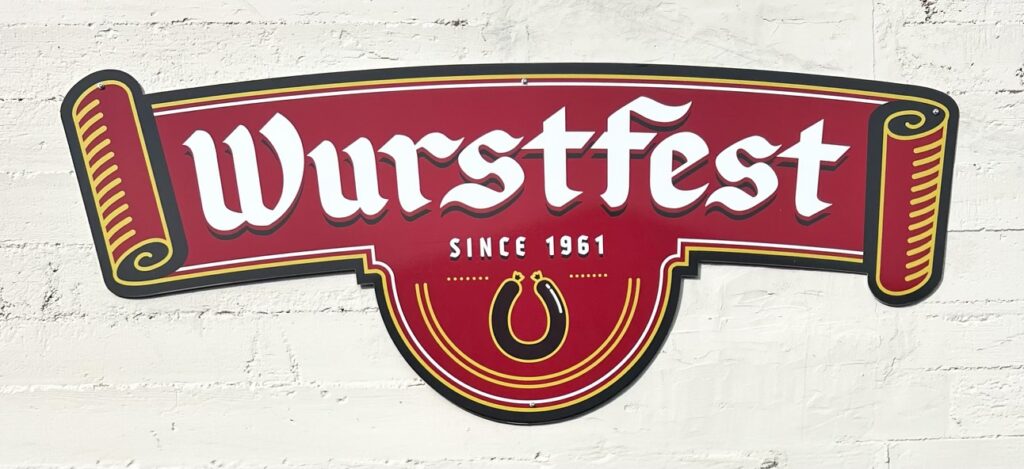
In order to analyze the Texas German-belt and the background of Wurstfest, several primary sources have provided a deeper look into the cultural-economic framework behind the founding of the celebration. In particular, the Sophienburg “Reflection Tapes” comprise firsthand interviews with the founders of Wurstfest and its presidents over the years, providing knowledge of its creation. In addition, Dennis Wehrmann’s “Franconia Brewing Interview” describes the history and foodways of Texas Germans, the importance of beer culture, and how it was inspired by Oktoberfest – a major influence on Wurstfest.3 These sources shed light on the prior knowledge of the Wurstfest founders who consciously linked it to the strong local ethnic history and utilized it to advertise the sausage-making industry for economic benefit. Similarly, knowledge of how to make sausages was passed down by generations of Texas Germans, making a product whose sales would sustain the city for decades.
While the Wurstfest has not received widespread scholarly attention, we did find a few works. Alton Rahe, a trained researcher and member of the Wurstfest Association, authored Wurstfest, a concise history of the festival geared toward the general public.4 Moreover, our analysis ties in with research on migration and heritage tourism, such as Joy Kristina Adams’s dissertation, “Going Deutsch: Heritage Tourism and Identity in German Texas.” In it, she explores the role of tourism in the creation and maintenance of contemporary German-American ethnic identity, detailing the impacts of Wurstfest on Texas-German identity.5 Kathleen Conzen and Heike Bungert have also done similar work detailing the role of German festivals in the United States and diving into the role of festivals in identity formation, focusing on the impact of foodways, respectively.6
Ethnicity as a Founding Principle of Wurstfest
In 1844, the Adelsverein’s first commissioner, Prince Carl of Solms-Braunfels, traveled to the Texas Hill Country and founded the German settlement of New Braunfels, which eventually welcomed over 5,000 German immigrants.7 Since then, the Texas Hill Country has become known for its rich German heritage, symbolized by the local annual Wurstfest. Men and women donning German-style dress, eating sausages, drinking beer, singing, and dancing – through these symbols and traditions, Wurstfest’s (historic) ethnic components come to life. It is these characteristics that raise the question of the depth at which ethnicity, or, rather, the celebration of ethnicity, was considered when it was founded.
The man credited with founding Wurstfest, Dr. Ed Grist, lived in New Braunfels and worked as a veterinarian and meat inspector, so he understood the importance of sausage making. In 1959, his son had returned from Germany after serving in the U.S. Army. Having attended the Oktoberfest in Munich, he recounted his experiences to his father. This inspired Grist to “have a German-themed party,”8 and he began pitching the idea to locals, eventually succeeding with the city council. Tom Purdum, another founder of Wurstfest, said Grist “was dedicated to this community and to the German heritage in it.”9 Grist’s enthusiasm about linking his son’s Oktoberfest experience to New Braunfels’s German history was decisive in turning Wurstfest into a celebration of German heritage and ethnicity. Interestingly, this celebration of German heritage extended past the descendants of the original German settlers as Grist was not ethnically German. Regardless, he prided himself on paying homage to the German heritage of the town, utilizing existing ethnic traditions to invent a new and supposedly authentic German event.
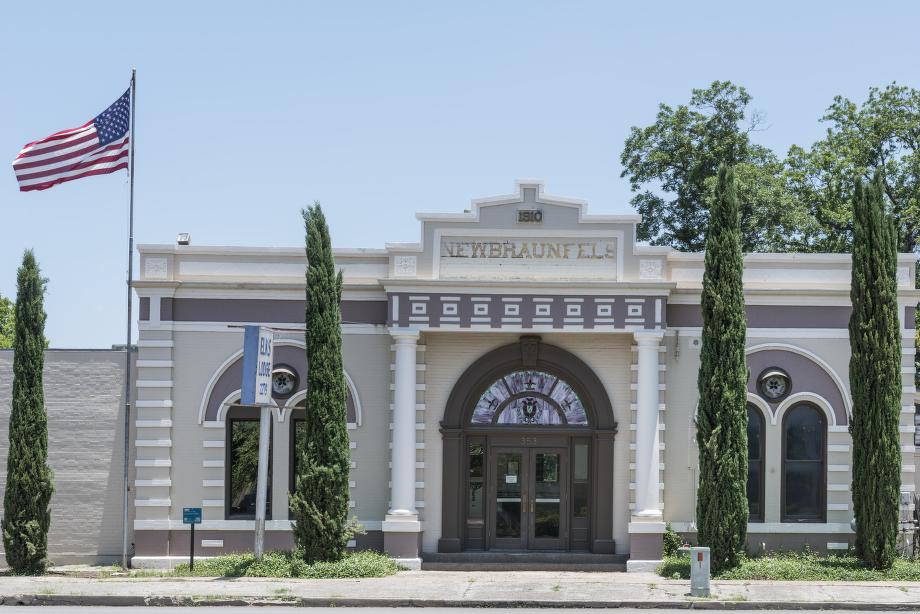
From the first Wurstfest onward, tourists and natives of New Braunfels have worn German-style clothes such as lederhosen and dirndls. German bands, German singing societies, and square dance groups have performed, outwardly expressing the city’s German heritage to reinforce the importance of ethnic celebration and heritage preservation – factors taken into account by the founders.10 Furthermore, Dachshund races have become a staple Wurstfest tradition. Although these outward expressions “do not represent all of Germany, they do belong to German traditions to a certain degree.”11 Steven Hoelscher, a professor of American Studies at the University of Texas at Austin, describes this phenomenon as “geographical verisimilitude” – the extent to which a tourist attraction duplicates the cultural landscape of the country of ethnic origin.12
At the same time, as much as Wurstfest was inspired by German culture and Oktoberfest, the celebration also served as a medium for Texas Germans to (re)construct their ethnicity and (re)invent their own tradition. Eric Hobsbawm describes this invention of tradition as a set of practices of a ritual or symbolic nature that are governed by tacitly accepted rules; these practices seek to inculcate certain values and norms of behavior by repetition, implying continuity with the past.13 By no means was there an absence of a Texas German identity before Wurstfest; however, Wurstfest provided a new opportunity for those of German heritage in New Braunfels to express and celebrate their ethnicity. Wurstfest, a festival deeply inspired by Munich’s Oktoberfest, has created its own traditions to reflect the culture of Texas Germans, and, more specifically, those of New Braunfels, whose citizens and visitors have practiced them for over sixty years now.
Foodways as a Founding Principle of Wurstfest
In his 1845 diary, Solms-Braunfels detailed his experiences leaving New Braunfels en route to Germany, noting that he ate sausage with the Schrimpfs, who ran a slaughterhouse and meat market, in Houston.14 Sausage culture in Texas did not begin with Wurstfest but had been developing for over a century, heavily influenced by German (and Czech) immigrants.15 Thus, the celebration of sausages at Wurstfest highlights the foodways of Texas Germans and brings the community together. The core of Wurstfest lies in its foodways, and these foodways help unite the community.
In the hundred years of sausage making in Texas prior to the founding of Wurstfest, the number of sausage makers in New Braunfels exploded in size, increasing from three in 1855 to nineteen in 1961.16 At the festival, locals demonstrate the sausage-making techniques practiced by their ancestors in Germany. The first Wurstfest featured displays of traditional sausage-making equipment, with the mayor crowning the oldest sausage makers in New Braunfels the King and Queen of Sausage. Sausage is central to New Braunfels’s history and character, and the founders of Wurstfest found a way to use the festival to celebrate this.17 When interviewed about the first years of Wurstfest, Grist stated that he loved the philosophy of sausage-making with sausage equipment, recipes, and demonstrations.18 Just three years after the first celebration in 1961, New Braunfels was named the “Sausage Capital of Texas,” emphasizing the importance of (ethnic) food in the Texas-German Hill Country.19
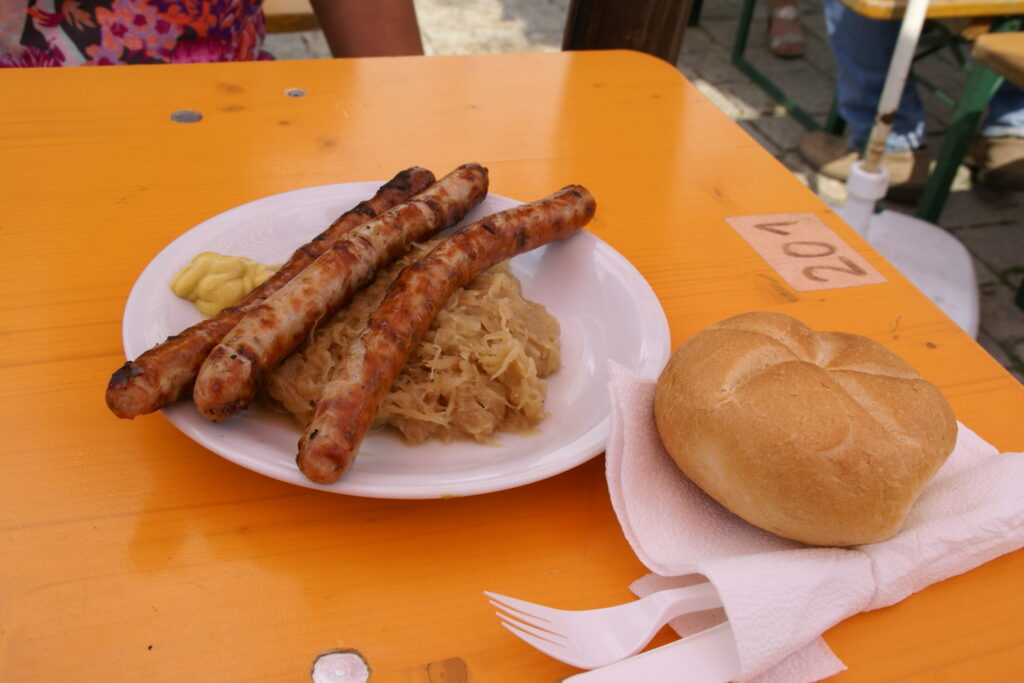
While sausage-making has a strong tradition in Germany, so does German beer culture. For instance, at the famous Oktoberfest, beer acts as the main ingredient that brings people together to socialize, eat, and enjoy themselves.20 With Oktoberfest serving as an inspiration for Wurstfest, one would assume that the beer culture in New Braunfels would reflect that of Munich during Oktoberfest. Yet, according to Harley Schultz, one of the founders alongside Grist, Wurstfest was never “meant to be a beer drinking contest; however, most of the people in New Braunfels were brought up on home brew and have lived happily drinking ‘Comal Ice Water’ and eating sausage.”21 Accordingly, the founders placed the emphasis on New Braunfels’s foodways not on beer but on the homemade sausage industry that the people could identify with. Ultimately, this distinguishes the sausage festival from other German-themed Oktoberfest celebrations across the U.S.
The Local Economy as a Key Principle in Wurstfest’s Founding
When establishing Wurstfest, the founders clearly felt that the expression of German heritage and ethnicity alongside the celebration of Texas-German foodways were of great importance. Yet, Wurstfest was also to function as an anchor for local tourism. In the 1960s, Canyon Dam and then Canyon Lake were constructed, launching a river tubing industry, prompting the city to focus on creating a tourist economy.22 The city council members understood that the city needed to attract visitors to get the turnout they hoped for with the lake, so they had to find ways such as Wurstfest to do so. Furthermore, with mass tourism pumping money into the local economy, Wurstfest raised profits that could be reinvested into the community. In her dissertation, Adams examined the intersection of postwar German-themed festivals and tourism and found that tourism became an increasingly important economic development strategy for cities like New Braunfels.23 This idea was central in the founding of the first festival, so much so that the Amtliche Stadt Wurst Kapelle (Official City Sausage Band) was formed to promote the sausage celebration. Members of the city would perform in neighboring cities such as Austin and San Antonio on the local radio station to advertise the event.24
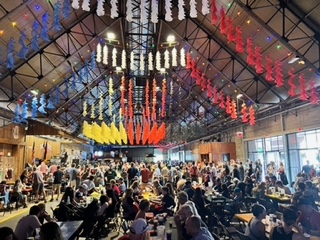
Arguably, Wurstfest’s main mission is to improve the local economy through tourism while preserving the German heritage of New Braunfels. Grist underlined this in his description of the purpose of the festival: “to utilize what we have at home and build sausage-making into a major industry in New Braunfels. … If an idea will help build the livestock industry, it will help every segment of our local economy.”25 As a result of the festival’s popularity, Wurstfest brings millions of dollars to the city every year, which it can redirect back into the local economy for community welfare, city maintenance, and other public works.
Conclusion
Since 1961, Wurstfest has continually grown to become one of the largest German-American festivals in the nation. For its founders, it was important to connect the festival to the Texas-German heritage prevalent in New Braunfels, so they sought to find symbols that would fulfill this purpose. Foodways also played an important role in the founding of Wurstfest. Grist initially imagined a sausage festival celebrating local sausage makers, which plays into the foodways not only of Texas Germans but also into the barbeque culture of Texas in general, appealing to a wide range of tourists. In turn, these tourists are central to Wurstfest because they contribute to the local economy. Wurstfest brings in large numbers of visitors to New Braunfels to try local sausage and swim at the lake. Arguably, boosting the economy and advertising local businesses seem to have been the major incentives for its founding.
The knowledge passed down for generations after the arrival of the initial immigrants arrived with the Mainzer Adelsverein kept the German heritage and sausage-making traditions of the town alive. The founders of Wurstfest utilized this knowledge to attract visitors from neighboring towns and states to support New Braunfels financially, and in this, they have already succeeded for decades. It is likely the tradition will continue for many more.

Aiden Maliskas is a sophomore at the University of Texas studying History and Art History. He is interested in human geography and the historical events that influence it.

Mark McShane is an undergraduate student at the University of Texas at Austin. He is interested in American and Germanic Studies and transatlantic migrations (diaspora) to the Americas.
- N. N., “Wilkommen zum Wurstfest,” New Braunfels Herald-Zeitung (New Braunfels, Texas), October 26, 1986; N. N., “Wurstfest Attendance Surpasses 200k Mark on Final Day in New Braunfels,” New Braunfels Herald-Zeitung, November 15, 2022. ↩︎
- Herb Skoog and Suzanne Herbelin, interview by Roxolin Krueger, October 24, 2002, Reflection Program #1084, recording, Sophienburg Museum & Archives, New Braunfels, Texas. ↩︎
- Dennis Wehrmann, “Franconia Brewing Interview,” interview by Niko Tonks, Foodways Texas, Craft Brewery Project, August 11, 2011, Audio 46:23. ↩︎
- Alton J. Rahe, Wurstfest, New Braunfels, Texas, The First Fifty Years…. Since 1961 (n.p., 2011), 5. ↩︎
- Joy Kristina Adams, “Going Deutsch: Heritage Tourism and Identity in German Texas,” diss., University of Texas at Austin, 2006. ↩︎
- Kathleen Conzen, “Ethnicity as Festive Culture: Nineteenth-Century German America on Parade,” in The Invention of Ethnicity, ed. Werner Sollors, 44–55 (Oxford, 1991); Heike Bungert, “‘Feast of Fools’: German-American Carnival as a Medium of Identity Formation, 1854–1914,” Amerikastudien/American Studies 48, no. 3 (2003): 325–44. ↩︎
- Louis E. Brister, “Adelsverein,” Handbook of Texas Online. ↩︎
- Allison Cook, “Wurstfest: The Love Child of Oktoberfest and Central Texas,” Wurstfest, November 21, 2013. ↩︎
- N. N., “Founder of Wurstfest Dies at the Age of 79,” New Braunfels Herald-Zeitung, September 20, 1994. ↩︎
- N. N., “Sausage ‘Capital’ Celebrates,” Austin American-Statesman, November 5, 1963. ↩︎
- Jamie Mueller, “Das größte deutsche Volkfest in Amerika,” Caterpillar Spirit, March 1, 2012. ↩︎
- Steven D. Hoelscher, “White Ethnics and the Romance of Place,” in Worldview Flux: Perplexed Values among Postmodern Peoples, ed. Jim Norwine and Jonathan M. Smith, 65–86 (Lanham, 2000), 76. ↩︎
- Eric Hobsbawm, “Introduction: Inventing Traditions,” in The Invention of Tradition, ed. idem and Terence Ranger, 1–14 (Cambridge, 1983), 4. ↩︎
- Carl Solms-Braunfels, Voyage to North America, 1844–45, transl. and ed. Wolfram M. Von-Maszewski (Denton, 2000), 151. ↩︎
- Sharon Hudgins, “Texas Barbecue: A Feast for all Classes,” in Oxford Symposium on Food & Cookery, 1990: Feasting and Fasting: Proceedings, ed. Harlan Walker, 106–20 (London, 1991), 106. ↩︎
- Rahe, Wurstfest, 5. ↩︎
- Ibid. ↩︎
- Herb Skoog, “Grist Family; Veterinary Medicine,” interview by Herb Skoog; Reflections Program #60, Sophienburg Museum & Archives, January 19, 1978, recording, Audio 46:32. ↩︎
- Jack R. Davis, The Boerne Star, November 26, 1964. ↩︎
- Wehrmann Audio 46:23. ↩︎
- N. N., “Look to the Future, Schulz Urges Readers,” New Braunfels Herald-Zeitung, November 14, 1982. ↩︎
- Vianna Davila, “Growth Changing Character of New Braunfels,” The Monitor, July 24, 2016. ↩︎
- Adams, “Going Deutsch” 228. ↩︎
- N. N., “Wilkommen zum Wurstfest,” New Braunfels Herald-Zeitung, October 26, 1986. ↩︎
- N. N., “Six Years of Wurstfest Best for Town,” The New Braunfels News, November 3, 1966. ↩︎
